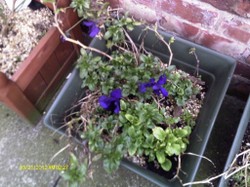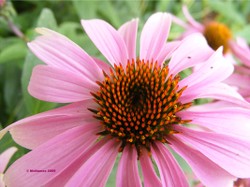The word Permaculture derives from the words permanent and agriculture. It attempts to produce a form of cultivation that makes use of minimum energy for maximum results. One of its main tenets is that energy and resources should be put to maximum use before leaving the system. Permaculture is also a design process that specifes how to create and construct systems according to its design principles, and it is a state of mind and to some extent a philosophy of life

What is Permaculture?
by frankbeswick
Permaculture is a means of farming/gardening in harmony with the environment rather than against it.
Basic principles
Permaculture was established by Bill Mollison, an Australian agriculturalist, who realized that modern farming systems were using excessive energy because they were farming out of kilter with the environment. He realized that such systems were energy and labour extensive, and ultimately unsustainable. His alternative was to design a system in which energy use and labour were minimized. This he hoped would be a system of permanent agriculture: hence perma[nent] [agric]culture.
Permaculture is part of the broad movement of ecological agriculture, which aims to farm and garden harmoniously with the environment. Thus while it is not part of the organic movement, it is compatible with organics and overlaps much with it. The techniques are complementary, as permaculture is concerned with designing systems for minimum energy for maximum effect.
Essential to Permaculture is designing waste out of the system. In Mollison's view waste is failure, and waste items are resources that are not adequately used. Thus water, which in Mollison's native land is at times and places a scarce resource, should not be frittered away but should be designed into recycling systems that make maximum use of it before evaporation takes it away. Similarly animal waste shoud be part of the permaculture strategy. So far there is little here to distinguish it from organics, but one distinction is that permaculture likes to keep soil fully mulched, and it argues that a piece of bare soil is a resource unused that is open to weeds.
Permaculture
 | Gaia's Garden: A Guide to Home-Scale Permaculture, 2nd Edition The first edition of Gaia’s Garden sparked the imagination of America’s home gardeners, introducing permaculture’s central message: Working with Nature, not against her, results... |
Zones
Division of land into zones is essential to the permaculture design process. But designation into zones is at the end of a process of observation and reflection. When I did my permaculture design certificate we were trained to observe and reflect on the site that we were designing. You take into account all geographical features of the land: its aspect, is it north or south facing; its latitude, how far north or south is it, where the winds come from at which times of year; hours of sunlight; is it on a slope or a flood plain, etc. All these factors influence what cultivated on the site. For example, if you find a frost pocket, there is no point in growing dwarf fruit trees there.
The permaculturalist will also design into the site remedies for its defects. Permaculture designers in hot climates construct swales to control and save water for the dry seasons. They will construct protection systems to prevent earth being washed away. These systems often involve the use of trees, whose roots stabilize soil, but permaculturalists are not averse to artificial constructions, such as terraces, which stabilize soil. There is no predetermined template, the needs of the site determine the strategy. Important to permaculture design is prevention of soil loss, which can be a major problem in parts of the world. This problem can be caused by floods washing soil away or heavy rain drops breaking up soil. The permaculture remedy is tree cover and mulch, along with water management systems such as damns and swales.
The zones
Designation into zones determines what you do with an area.
Zone 1 house and grounds [some permaculturalists distinguish a zone 0 for the house and keep the number 1 for drive and ornamental gardens
zone 2: productive gardens
zone 3 fields and orchards
zone 4:Semi-wilderness, land not often visited, such as moorland that is farmed for sheep.
Zone 5: Wilderness. Britain has little wilderness, but if you have a beach on your land it is to be designated as zone 5 for cultivation purposes. Mountain tops and the rougher mountain territory are zone 5. If you have land in parts of the United States or Canada you may have much wilderness for your zone 5. Willderness is useful mainly for hunting and foraging, though its spiritual and recreational value is enormous.
Few permaculturalists have all zones. My land is 1 and 2, the 2 being the allotment.
Permaculture
 | Sepp Holzer's Permaculture: A Practical Guide to Small-Scale, Integrative Farming and Gardening Sepp Holzer farms steep mountainsides in Austria 1,500 meters above sea level. His farm is an intricate network of terraces, raised beds, ponds, waterways and tracks, well cover... |
Perennials
Permaculture loves perennials, plants that return year by year or grow through the year, and there are no plants that are as perennial as trees. Permaculture loves trees. It favours crops to which the grower can return again and again for products. These could be cut and come again lettuce, but they could also be fruit and nut trees or maybe berries. As it is not a dogmatic philosophy, it accepts that annuals, such as potatoes, have their place.
A system favoured by permaculturalists is the forest garden. This has been developed independently of permaculture by various "underdeveloped" peoples of the world [I use the word ironically.] In parts of Africa and in Goa the indigenous population have produced a kind of forest garden horticulture that demonstrates extremely high skills of cultivation that make the western monocultures favoured by the agricultural giants look primitive, as they are. But Permaculture has taken up the forest garden and eagerly promoted it.
Forest gardens work in layers, the number of layers varying as to where in the world you are. In Goa the immensely productive gardens have several layers of large trees,along with multiple layers of other crops, but in some areas the number of layers is fewer. The trees provide the gardeners with not only food, but other products, such as wood, and they are harvested in a controlled, sophisticated way that has produced plenty for their growers for centuries; and westerners like to call these people underdeveloped!
The layers of a forest garden
1;Large Trees; used for wood, beneath their canopy come
2; Smaller trees, used for fruit and nuts, beneath them come
3: Shrubs and bushes for berries
4: The climbing layer. In some climates creepers with a productive use are allowed to grow up the trees, for example some kinds of beans
5: The ground layer, such as cabbages and peas
6: Roots, such as potatoes.
The vegetables will be grown in clearings between trees and sometimes it will be necessary for there to be raised beds.
The types above are not set in stone. Medium sized trees can also be grown in complex systems. In Britain, where such forest gardens would be small, we might dispense with large trees and focus on small fruit trees surrounded by berries. It is important to say, though, that these types are not separated into beds, but are integrated throughout the garden. The smaller trees grow among the larger ones, and vegetables will be cultivated in clearings. We would also note that specific circumstances affect what can be grown. Since the arrival of the American grey squirrel in Britain hazl nuts have been harder to grow, as the squirrels eat them. You will have to do something about squirrels if you want nut trees, which are considered important by permaculturalists.
Animals may be kept and allowed to forage for fodder, Pigs are extremely good for this, and chickens may be allowed to peck at the ground, though they must always be protected from predators. Forest gardening is not necessarily vegetarian, and Permaculture is not committed to either meat eating or vegetarianism, though indvidual permaculturalists have their own choices. It is possible that aquaculture could be integrated into this kind of system, though it is not normally done.
Permaculture also emphasises the importance of edge. The ares between zones can be productive, and in the forest garden the edge could be where you place your greenhouse.
Forest Gardening
 | Creating a Forest Garden: Working with Nature to Grow Edible Crops Offering inspiration for all gardeners, this book features beautiful color photographs and illustrations throughout, and is divided into two parts. Part One looks at why and how... |
 | Secret Garden of Survival: How to grow a camouflaged food- forest. Imagine a food garden that you only have to plant once in your life-time, that takes up very little space, that will provide food for you and your family for the next 30 years; ... |
Forest Gardening
 | Forest Gardening: Cultivating an Edible Landscape, 2nd Edition An English classic revised and expanded for North America Forest Gardening is a way of working alongside nature--an approach that results in great productivity with minimal main... |
Small gardens
Permaculture does not require a farm sized area. Permaculturalists will apply their principles even in terraced houses or flats. They will do this by making an assessment of the possibilities of the property and then designing accordingly. They will note areas where indoor cultivation is a possibility, such as the region under the stairs for mushrooms. They may grow on window ledges, especially those that take full sun. They will use their yard space for container gardening. Maybe walls can have boxes pinned to them for cultivation. A shed roof can be a green roof. My yard contains a small grow-house, in which I cultivate seedlings to take to the allotment.
Permaculturalists are also aware that they are not working only as individuals. Working in harmony with communities and using permaculture principles is a vital part of the permaculture philosophy of life. Strong communities composed of happy and prosperous, though not excessively rich individuals in friendly and co-operative fellowship with each other is the Permaculture ideal.
Permaculture is not a goal to be obtained, whereupon you sit back and say "sorted!" It is an ongoing process where you attempt to realize the permaculture ideal in your own life. Nor can you have a single bed on your plot reserved for permaculture. Either the whole is Permaculture or it is not. It is an ongoing process where you learn from others in the movement as you make your own socially and ecologically friendly path through life.
Container gardening
 | The Edible Container Garden: Growing Fresh Food in Small Spaces "No space is too small to grow delicious and healthy food."Enjoying tasty and fresh produce no longer requires a trip to the local farm stand or gourmet grocery. With "The Edibl... |
You might also like
On April 22, Celebrate Earth Day and Help Protect the PlanetEarth Day can result in positive changes for the environment, if enough peopl...
How to Eliminate / Get Rid of Stinky OdorsSome odors smell bad for a while and then go away. But bacteria feed on cert...



 Women of the Gospelson 10/11/2025
Women of the Gospelson 10/11/2025
 Religious Gardenson 08/25/2025
Religious Gardenson 08/25/2025
 Doctor of the Church: John Henry Newmanon 08/03/2025
Doctor of the Church: John Henry Newmanon 08/03/2025
 Restoring the Palm Houseon 07/16/2025
Restoring the Palm Houseon 07/16/2025



Comments
Opinions differ. Some say house and grounds are all one zone, but others use zero for the house.
The first and the second paragraphs to the first sub-subheading, The zones, under the second subheading, Zones, advise us that "Designation into zones determines what you do with an area. Zone 1 house and grounds [some permaculturalists distinguish a zone 0 for the house and keep the number 1 for drive and ornamental gardens."
How does permaculture deem the house and immediately around-the-house?
I mulched to about three inches.
Thank you!
Six inches (15.24 centimeters) gives such an attractive end-point that concomitantly helps arborists have access to the lowest above-ground part of the tree as well as to soil and trunk problems and to stem-girdling roots!
How high do you tend to pile your mulches?
I used to go about six inches from the tree base.
The last sentence to the third paragraph under the first subheading, Basic principles, advises us that "So far there is little here to distinguish it from organics, but one distinction is that permaculture likes to keep soil fully mulched, and it argues that a piece of bare soil is a resource unused that is open to weeds."
Last week I attended a digital webinar about tough Unitedstatesian trees. The host and the presenter, respectively from the University of Massachusetts-Amherst and the University of Iowa-Ames, through the former's riveting Urban Forestry Today webinar series, broached mulching as not too close to, not too far from, the trunk base; not too much before, not too much after, the drip line; and not too thin, not too thick.
How close to the tree base, how far from or near to the drip line and how high do you like your mulch?
Thank you for the completely workable tips! And Bon appétit to you and Maureen and you all's family.
My mushrooms are growing nicely in the kitchen, and we might have them with dinner tonight.
The space under the stairway seems an ideal spot for mushrooms, but you I'll need to ensure an adequate airflow. Also mushrooms benefit from some light, though they do not photosynthesis.
Thank you!
The basement has a door that opens onto the ground-floor living room from the 13 -- ;-{ -- step stairs to the basement living room. That 13-step stairway has underneath it a 5-foot-5-plus-inch (1.65-plus-meter) crawl space, actually a standing-up space since I stand up comfortably in it.
That sub-stairway space has its own door. I generally keep it -- and the door to the upper-level living room -- closed apart opening both doors one day a week to keep the basement space aired.
It seems to me that the crawl-space floor and/or the crawl-space wall shelves work for growing mushrooms. Light would come from the basement outside door -- the lower half of which is wood, the upper half of which is glass -- and the two basement windows.
Would that work, having the mushrooms inside the under-the-stairway crawl space?
If so, would that work better for mushrooms there with the under-the-stairway crawl-space door always, never, sometimes closed?